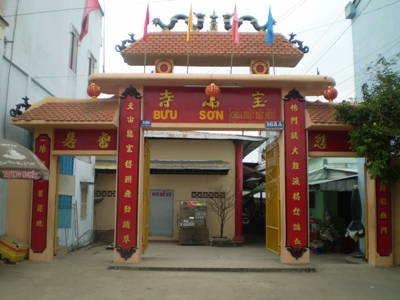DAT SET POGODA (CLAY POGODA) - A PROVINCIAL LEVEL CULTURAL HISTORY RELIC
29/03/2022
Along Ton Duc Thang street, in Cluster 1, Ward 5, about 1km from Kh'leang pagoda to number 163a is a small temple on the right hand side with a row of chinese characters with the name "Buu Son Tu" – 寶山寺 (Bao Shan Temple in Chinese) solemnly carved at the main gate of the temple. However, people around the area are still familiar with the simple name "clay pagoda" where thousands of statues are kept, all made from clay.
According to the elders, before, Buu Son was just a small temple built in the early 20th century, more than 100 years ago by Ngo family for home worship. Until the fourth abbot, Mr. Ngo Kim Tong (1909 - 1970) embellished and expanded to have the current Buu Son Tu. Buu Son Tu has an area of about 400m2 with simple architecture with wooden pillars and corrugated iron roof. the special thing about this temple is that thousands of buddha and animal statues are designed very vividly and made of clay, which Mr. Tong has painstakingly created for 42 years (from 1928 to 1970). Visitors to Dat Set pagoda all admire the genius who used a lifetime's determination and admiration for the buddhism to create this marvelous work.

The main gate of Dat Set pogoda
When Mr. Ngo Kim Tong was a child, he was often sick. In 1929, when he was 20 years old, he was seriously ill and thought he could not survive. His family could only take Mr. Tong to a mountain temple in An Giang province for treatment and to pray to God and Buddha. Combining taking medicine and practicing meditation, he gradually recovered and determined to become a monk at the age of 20. When he was young, he was engrossed in modeling sculptures and prototypes from other people. Simple paintings on the Buddha's altar of his father, daily objects, fruits around the house became diverse topics for him to use his molding skills with the main material of clay around the area. After recovering from his illness, he became passionate about making statues and took care of the temple on behalf of his father from the 1930s to the 1970s. With a rare passion, Mr. Tong worked hard in learning and searching for formula, method to create these priceless works of art without training. Just from daily experiences, he created clay sculptures with extremely rare religious historical value.
The raw materials used for making statues are mainly clay, dug by Mr. Tong from the fields a few kilometers away from the temple. He dried, then put the clay in a mortar and use a pestle to smooth, filter out impurities and roots. He mixed the fine soil with sawdust to make incense (incense powder) and acacia to form a fragrant, flexible mixture. At that time, he just started to shape the statues which were smooth, not cracked. In addition, he also researched and applied ways to support the shaping of statues with high aesthetic requirements. He used zinc nets, wooden trees to build the ribs, then covered with mosquito nets and mixed materials to make statues. The surface is covered with a layer of water-based metallic paint and varnish. Not only with skillful and talented hands, but also with his extremely rich imagination, hundreds of large and small statues were formed without overlap. Each statue has different look and clearly shows the spirit on each face. It is also the result of the mind of a person who has a Buddha-oriented heart and brings sweetness to life diligently and quietly.
Stepping through the temple's three-door gate, following the concrete road to the side door, we will see a large white elephant about 2m high as if welcoming visitors, then go to the main hall to worship Buddha. The typical feature in the arrangement of Buddha statues here shows the idea of "Three Community Religions" (Buddha-Confucianism-Lao) with the Buddha system: Amitabha, Bodhisattva Avalokitesvara, Confucius, Jade Emperor of God, Lao Tzu, Maitreya Buddha,...
Mr. Ngo Kim Tong also created other works such as: Da Bao tower made in 1939 when he was 30 years old. It is about 4m high, designed very sophisticatedly. The tower has 13 floors, each floor has 16 doors, each door has a Buddha image. In total, Da Bao tower has 208 doors, 208 Buddhas and 156 dragons supporting each tower roof. The bottom part of the tower worships the the Maharayana Lotus Sutra, which represents the Jade Relic of the Buddha. Next to it is "The tower welcoming the Buddha to the world to transmit the sutra" or called "The Lotus Palace". The palace consists of one thousand lotus petals and on every petal sat by one meditating buddha. Under the lotus palace is “Thien Tien Bagua” consisting of 8 palaces, that is "Can, Kham, Can, Chan, Ton, Ly, Khon, Doai"; each palace has two fairies standing in service. Under the lotus and Bagua there are four heavenly kings. Looking at this tower and lotus platform as a whole, visitors will immediately think of a brilliant and talented sculptor who has taken advantage of Buddhist teachings to create statues that can represent the Buddha's will.